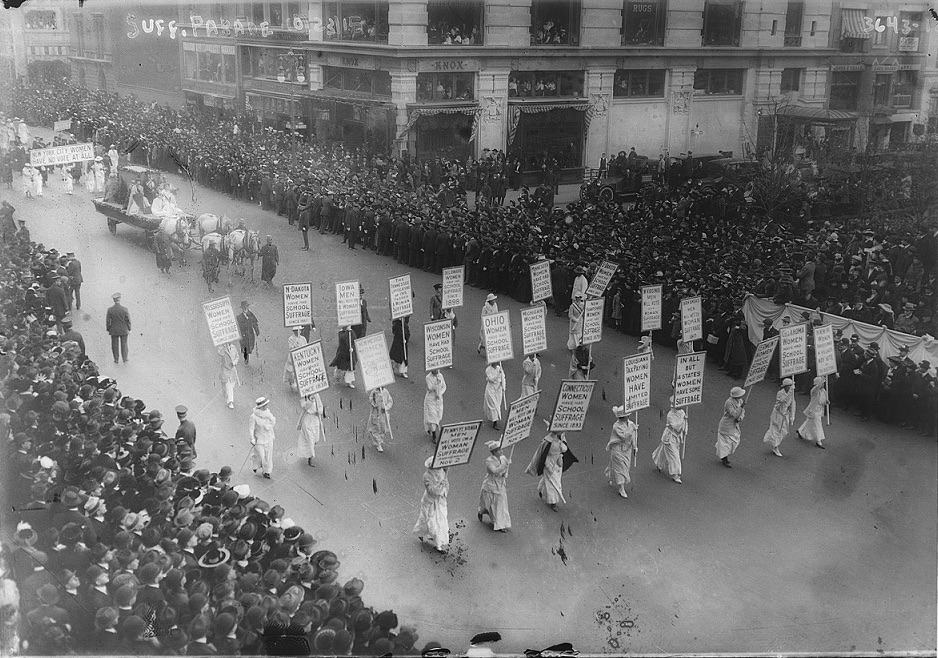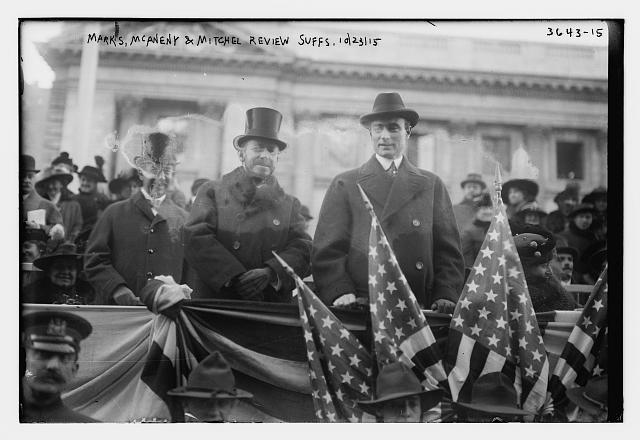For once, the biggest news story in America in 1915 was not about the war waging in Europe.
On October 23, 1915, the forces of the women’s suffrage movement mobilized to create the most ambitious gathering to date, a parade of thousands to force the issue into the consciousness of New Yorkers and American at large.
Here are some clips from newspaper articles of the day, celebrating their efforts, chastising and trivializing in part, but recognizing that a corner had been turned and that the right to vote for American women was now an inevitable (if not immediate) outcome:

“The latest, biggest and most enthusiastic of suffrage parades, and the one which, according to the leaders of the suffrage forces, will be the last ever needed to plead their cause in New York, marched up Fifth Avenue from Washington Square to Fifth-Ninth Street yesterday afternoon, blazoned the whole city with the yellow of its banners, and brought out what seemed to be the larger part of the population of Manhattan to look at them.”
— New York Times, October 24, 1915
“It was a three mile argument for equal rights — a dignified, splendid argument — and every vantage point along the gay colored way was covered with men and women who saw its force. Through the chill of a windy afternoon, though the sun shone on the mighty host, the great army of women passed, the white costumes of many glittering in the sunlight, defying the cold wind that the onlookers felt to their spines as they stood to see it all.”
— New York Sun, October 24, 1915
“Some whose names are to be found all through the Social Register marched side by side with working mothers with babies in their arms. A large proportion of the marchers were young girls who would not be old enough to vote were they enfranchised. They made up in beauty what they lacked in years and were cheered all along the crowded Fifth Avenue sidewalks.”
— New York Evening World, Late Edition, October 23
“Old women, as old as suffrage, marched. Often beside them were little girls barely in their teens. And there were even tiny babies in carts, making their appeal for their mothers’ votes.
There was little applause all along the route for the women marchers. But this was not strange, for it could be seen that the spirit of the parade had made itself felt on the sidewalks. It was no laughing matter, this parade. The women in it did not smile or giggle. They were serious and determined. And this mental characteristic was contagious.”
— New York Tribune, October 24
Above: Four women carrying ballot boxes on a stretcherÂ
“Is Dame Nature a suffragist? At any rate, she was kind yesterday. In golden sunlight and keen air the great parade went its triumphal way, to the satisfaction of participants and spectators. With no disrespect to the men in it, the female marchers and riders, as always, showed the hopeless feminine superiority in grace, decorative effect, art of representation.”
— editorial, New York Times, October 24
“The spectators laughed in good natured sympathy with the struggles which the wind caused the marchers.
Unruly skirts demanded attention from those who bore the militantly inscribed banners.
Nearly all the flag carriers had to call for help upon heir companions and sometimes four or five women struggled with brave laughter with a single standard to keep it from being swept to the street.” — NY Evening World
“[S]igns were a cardinal feature of the parade. One which attracted attention everywhere and appealed significantly to the male onlookers was, “We talk with you, we eat with you, we dance with you, we marry you, why can’t we vote with you?” Another read: “Oh, men, please do give us the vote.” — NY Tribune
“King Albert of Belgium favors votes for women,” “Australian women have the ballot,” “Queensland women vote,” “Bohemia was the first in the world to pass a law for women’s suffrage in 1861,” “Oestreichischer Komite fur Frauenstremrecht” were some of the inscriptions on the banners. In all the languages of the earth they proclaimed the advance women have made in the various countries in gaining the vote, and scattered through the division were banners asking: “Women vote in Australia, why not in New York?” and “Women vote in twelve Western States, why not in New York?” — NY Sun
“It was a long parade — begun in mid-afternoon and finished by moonlight. And while thousands had drifted away, the avenue was still packed with onlookers when the men’s brigade — some thousands this time in place of the valorous ninety-two who were jeered in the first parade only four years ago — came along just in front of the army of automobiles that ended the procession.” – NYT
“The parade ended with a concert of thirty bands and a giant chorus singing patriotic songs at the Central Park Plaza. Â There were several battalions of men in sympathy with the cause which were noisily greeted by the people along the curb.” — Evening World
Graphic from the New York Times, October 24
Margaret Vale, niece of President Woodrow Wilson, at the Suffrage parade. Alaska had granted women the right to vote in 1913.
The appearance of Mayor John Purroy Mitchel (‘the boy mayor of New York‘) was considered a big boost for the marchers although it certainly would have been a major snub if the mayor has skipped such a major parade!
Absent from all of the news coverage (at least the articles I reviewed) was the participation of African-American suffrage advocates. They played an active role in the movement but were most likely absent from the parade.
Despite this grand parade, New Yorkers defeated a referendum on suffrage the following month. A little over two years later — on November 6, 1917 — the women of New York state would win the right to vote.
The Nineteenth Amendment, ensuring the vote for all American women, was ratified on August 18, 1920.
All photographs on this page courtesy Library of Congress












3 replies on “Suffragettes on Parade! In 1915, thousands march for right to vote”
Awesome page. I’m trying to find info on when Mott and Stanton streets got their current names, and if they were named in honor of the suffragettes. Do you happen to know?
Ida B Wells, founder of Women’s Suffrage Club and AKAs marched too. Refusing to go to the back, Ida stayed in front.
Happy to have found some mentions in the newspapers of the day of black women participating–and a picture as well. https://digilab.libs.uga.edu/scl/exhibits/show/strategies-of-suffrage/item/1091